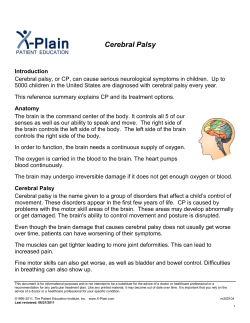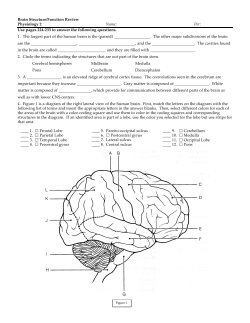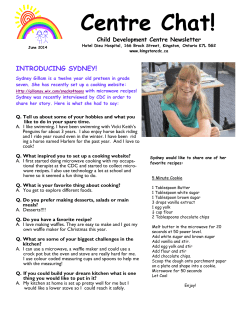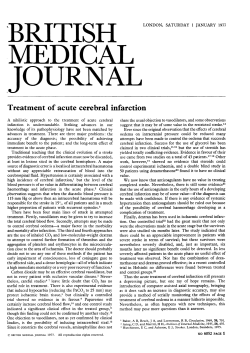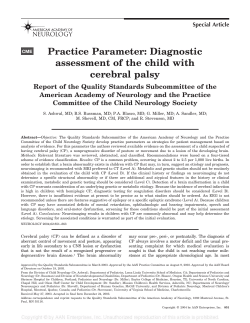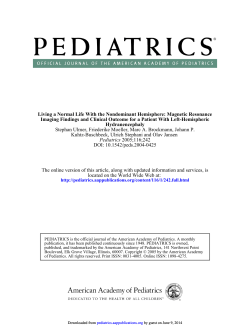
The following excerpt has been taken from the Christopher &... Paralysis Resource Center website.
The following excerpt has been taken from the Christopher & Dana Reeve Foundation Paralysis Resource Center website. http://www.christopherreeve.org/site/c.mtKZKgMWKwG/b.4453213/k.7D62/Cerebral_P alsy.htm# Cerebral Palsy Cerebral palsy refers to a group of conditions that affect control of movement and posture. Due to damage to one or more parts of the brain that control movement, an affected person cannot move his or her muscles normally. Symptoms range from mild to severe, including forms of paralysis. With treatment, most children can significantly improve their abilities. Although symptoms may change over time, cerebral palsy by definition is not progressive, so if increased impairment occurs, the problem may be something other than cerebral palsy. Many children with cerebral palsy have other problems that require treatment. These include mental retardation; learning disabilities; seizures; and vision, hearing and speech problems. Cerebral palsy usually is not diagnosed until a child is about 2 to 3 years of age. About 2 to 3 children in 1,000 over the age of three have cerebral palsy. About 500,000 children and adults of all ages in this country have cerebral palsy. The three major types of cerebral palsy: Spastic cerebral palsy. About 70 to 80 percent of affected individuals have spastic cerebral palsy, in which muscles are stiff, making movement difficult. When both legs are affected (spastic diplegia), a child may have difficulty walking because tight muscles in the hips and legs cause legs to turn inward and cross at the knees (called scissoring). In other cases, only one side of the body is affected (spastic hemiplegia), often with the arm more severely affected than the leg. Most severe is spastic quadriplegia, in which all four limbs and the trunk are affected, often along with the muscles controlling the mouth and tongue. Children with spastic quadriplegia have mental retardation and other problems. Dyskinetic cerebral palsy. About 10 to 20 percent have the dyskinetic form, which affects the entire body. It is characterized by fluctuations in muscle tone (varying from too tight to too loose) and sometimes is associated with uncontrolled movements (which can be slow and writhing or rapid and jerky). Children often have trouble learning to control their bodies well enough to sit and walk. Because muscles of the face and tongue can be affected, there also can be difficulties with sucking, swallowing and speech. Ataxic cerebral palsy. About 5 to 10 percent have the ataxic form, which affects balance and coordination. They may walk with an unsteady gait and have difficulty with motions that require precise coordination, such as writing. There are many things that occur during pregnancy and around the time of birth that can disrupt the normal development of the brain and result in cerebral palsy. In about 70 percent of cases, brain damage occurs before birth, although it also occurs around the time of delivery, or in the first months or years of life. Some of the known causes include: Infections during pregnancy. Certain infections in the mother, including rubella (German measles), cytomegalovirus (a mild viral infection), and toxoplasmosis (a mild parasitic infection) can cause brain damage and result in cerebral palsy. Insufficient oxygen reaching the fetus. For example, when the placenta is not functioning properly or it tears away from the wall of the uterus before delivery, the fetus may not receive sufficient oxygen. Prematurity. Premature babies who weigh less than 3 1/3 pounds are up to 30 times more likely to develop cerebral palsy than full-term babies. Complications of labor and delivery. Until recently, doctors believed that asphyxia (lack of oxygen) during a difficult delivery was the cause of most cases of cerebral palsy. Recent studies show that this causes only about 10 percent of cases. Rh disease. This incompatibility between the blood of the mother and her fetus can cause brain damage, resulting in cerebral palsy. Fortunately, Rh disease usually can be prevented by giving an Rh-negative woman an injection of a blood product called Rh immune globulin around the 28th week of pregnancy and again after the birth of an Rhpositive baby. Other birth defects. Babies with brain malformations, numerous genetic diseases, chromosomal abnormalities, and other physical birth defects are at increased risk of cerebral palsy. Acquired cerebral palsy. About 10 percent of children with cerebral palsy acquire it after birth due to brain injuries that occur during the first two years of life. The most common causes of such injuries are brain infections (such as meningitis) and head injuries. Cerebral palsy is diagnosed mainly by evaluating how a baby or young child moves. Some children with CP have low muscle tone, which can make them appear floppy. Others have increased muscle tone, which makes them appear stiff, or variable muscle tone (increased at times and low at other times). The doctor also may suggest brain-imaging tests such as magnetic resonance imaging (MRI), computed tomography (CT scan), or ultrasound. These tests sometimes can help identify the cause of cerebral palsy. How is cerebral palsy treated? A team of health care professionals works with the child and family to identify the child’s needs. The team may include pediatricians, physical medicine and rehabilitation physicians, orthopedic surgeons, physical and occupational therapists, ophthalmologists, speech/language pathologists, and social workers and psychologists. The child usually begins physical therapy soon after diagnosis. This enhances motor skills (such as sitting and walking), improves muscle strength, and helps prevent contractures (shortening of muscles that limits joint movement). Sometimes braces, splints or casts are used along with therapy to help prevent contractures and improve function of the hands or legs. If contractures are severe, surgery may be recommended to lengthen affected muscles. Drugs may be used to ease spasticity or to reduce abnormal movement. Unfortunately, oral drug treatment is often not very helpful. Sometimes injection of drugs directly into spastic muscles is more helpful, and the effects may last several months. A new type of drug treatment is showing promise in children with moderate to severe spasticity affecting all four limbs. During a surgical procedure, a pump is implanted under the skin that continuously delivers the anti-spasmodic drug baclofen. For some children with spasticity affecting both legs, selective dorsal rhizotomy may permanently reduce spasticity and improve the ability to sit, stand and walk. In this procedure, doctors cut some of the nerve fibers that are contributing most to spasticity. This procedure usually is done when a child is between 2 and 6 years of age. Research suggests that cerebral palsy results from incorrect cell development early in pregnancy. For example, a group of researchers has recently observed that more than one-third of children with cerebral palsy also have missing enamel on certain teeth. Scientists are also examining other events -- such as bleeding in the brain, seizures, and breathing and circulation problems -- that threaten the brain of a newborn baby. Some investigators are conducting studies to learn whether certain drugs can help prevent neonatal stroke, and other investigators are examining the causes of low birth-weight. Other scientists are exploring how brain insults (like brain damage from a shortage of oxygen or blood flow, bleeding in the brain, and seizures) can cause the abnormal release of brain chemicals and trigger brain disease. Sources: United Cerebral Palsy, March of Dimes, National Institute of Neurological Disorders and Stroke Web Sites www.ucp.org United Cerebral Palsy 1-800-872-5827 info@ucp.org 1660 L Street Suite 700 Washington, DC 20036 UCP's mission is to advance the independence, productivity, and full citizenship of people with cerebral palsy and other disabilities, through a commitment to the principles of independence, inclusion, and self-determination. http://cpirf.org Cerebral Palsy International Research Foundation 1025 Connecticut Ave., Suite 701 Washington, DC 20036 202-496-5060 Formerly UCP Research and Educational Foundation, no longer affiliated with UCP. www.modimes.org The March of Dimes Birth Defects Foundation 914-997-4488 1275 Mamaroneck Avenue White Plains, NY 10605 Features resources and connections to address four major problems threaten the health of America's babies: birth defects, infant mortality, low birth weight, and lack of prenatal care. www.ninds.nih.gov/health_and_medical/disorders/cerebral_palsy.htm The National Institute of Neurological Disorders and Stroke Offers fact sheets on CP. http://www.disaboom.com/Health/Cerebral-Palsy.aspx Disaboom: Cerebral Palsy http://www.aacpdm.org/index?service=page/Home The American Academy for Cerebral Palsy and Developmental Medicine (AACPDM) 414-918-3014 info@AACPDM.org 555 E. Wells Street Suite 1100 Milwaukee, WI 53202 AACPDM is a multidisciplinary scientific society devoted to the study of cerebral palsy and other childhood onset disabilities, to promoting professional education for the treatment and management of these conditions, and to improving the quality of life for people with these disabilities. The Academy was founded in 1947 "to foster and stimulate professional education, research, and interest in the understanding of these conditions and in improving the care and rehabilitation of affected persons." The diversity of the six founding members (an orthopedic surgeon, a neurologist, two pediatricians, a neurosurgeon and a physiatrist) signified the necessity for an interchange of ideas and experiences among all of those who provide care for patients with cerebral palsy. The foresight of our founders is reflected by the Academy's increasing membership of specialists in these and other disciplines. The scope of the Academy's interests has expanded from an initial focus on cerebral palsy into related areas of developmental medicine, including spina bifida, neuromuscular disease, traumatic brain injury and other acquired disabilities, genetic disorders, communications problems, and specific learning disabilities. www.stlouischildrens.org The Cerebral Palsy Center at St. Louis Children’s Hospital 314-454-6000 The Center is known for its spasticity management program using rhizotomy. http://www.uclaccp.org/ Center for Cerebral Palsy at UCLA 310-825-5858 mgreenberg@mednet.ucla.edu 1000 Veteran Avenue Room 22-64 Los Angeles, CA 90095-1795 Is an interdisciplinary clinic for the medical management of movement disorders in children with cerebral palsy. http://gait.aidi.udel.edu/res695/homepage/pd_ortho/clinics/c_palsy/cpweb.htm Cerebral Palsy: A Guide for Care from the Alfred I. DuPont Institute in Wilmington, Delaware www.theCPGroup.org The CP Group Information for those with CP as well as an online forum where messages and questions can be exchanged. http://www.familyvillage.wisc.edu/lib_cerp.htm Family Village—Cerebral Palsy Includes chat room listings and a variety of resources including international information and non-English speaking resources. http://www.nlm.nih.gov/medlineplus/cerebralpalsy.html MedlinePlus—Cerebral Palsy www.reachingforthestars.org Reaching for the Stars, Inc. 770-561-5950 info@reachingforthestars.org 3000 Old Alabama Road Suite 119-300 Alpharetta, GA 30022 A non-profit organization started by parents of children with CP. Creating a research foundation centered on the belief that leading-edge research by progressive scientists, physicians, and therapists can lead to a cure of CP. http://kidshealth.org/kid/health_problems/brain/cerebral_palsy.html Kids Health for Kids: Cerebral Palsy http://www.cpparent.org/ CPParent Resource Center CPParent is a group of parents, caregivers and others who work with children with cerebral palsy. http://www.uhms.org The Undersea and Hyperbaric Medical Society (UHMS) 410-257-6606 uhms@uhms.org 10020 Southern Maryland Blvd. Suite 204 Dunkirk, MD 20754 It provides information to improve the scientific basis of hyperbaric oxygen therapy. There are more than 2,500 hyperbaric scientist and physician members around the world. http://www.thecpnetwork.org The Cerebral Palsy Network They are a non profit corporation consisting of parents and individuals across the globe who share an interest in CP. http://www.cpisra.org/ Cerebral Palsy International Sports and Recreation Association CPISRA is committed to enhancing the opportunities for people with cerebral palsy or a related neurological condition to participate in the sport or leisure activity of their choosing. http://www.cprf.org/default.asp Cerebral Palsy Research Foundation 5111 East 21st Street N. Wichita, KS 67208 316-688-1888 info@cprf.org Providing people with disabilities customized services, supports and technologies, with an emphasis on employment and training options, to facilitate their chosen economic and personal independence. http://www.originsofcerebralpalsy.com/ Origins of Cerebral Palsy www.latexfreeswimwear.com Suits Me Latex-Free Swimwear Phone: 352-666-1485 Chat Rooms/Message Boards http://www.yahoo.com Yahoo offers several cerebral palsy message groups for connecting to the greater CP community. Click on “groups” on the home page and search for “cerebral palsy”. www.theCPGroup.org The CP Group Information for those with CP as well as a forum where messages can be exchanged. Magazines Cerebral Palsy Magazine Therasuit LLC PO Box 7005 Bloomfield Hills, MI 48302 Phone 248-706-1026 www.cerebralpalsymagazine.com A quarterly print publication. The following books and videos are available for free loan from the PRC library. For more information, please see www.paralysis.org and click the Lending Library tab. Books Appleton, Andrew B. The Disabled Father: The Story of a Father and His Son. Lincoln, Neb.: iUniverse, 2005. Appleton’s son has CP. Backa, Judy. Climbing a Mountain and Living with Cerebral Palsy. Townsend, Mont.: Broadwater Printing, 1992. Barker, George A. Jr. Moon Gate Dreams: A Quest for Romance and Adventure Beyond the Moon Gate. Bend, Ore.: Maverick Publications, 1997. Barker was left quadriplegic from a mosquito bite that gave him encephalitis. Diagnosed with a form of CP. Beamguard, Betty Wilson. How Many Angels Does it Take: The Remarkable Life of Heather Rose Brooks. Charlotte, NC: Pure Heart Press, 2007. Autobiography of a young woman with CP who learns to drive horses with adapted equipment. Berg, Kevin. A Life with Purpose: The Power of God Displayed Through the Struggles of My Life. LuLu, 2005. Bergman, Thomas. Going Places: Children Living with Cerebral Palsy. Milwaukee, WI: Gareth Stevens Children’s Books, 1991. Follows the day to day life of six year old Mathias in pictures and text. Bend, Cynthia Davidson. Arthur’s Room: Arthur’s Spirit Struggles to Escape the Cage of Cerebral Palsy. Edina, MN: Beaver’s Pond Press, 2002. Fiction interspersed with poems from a person with CP. Bratt, Berneen. No Time for Jello: One Family’s Experiences with the DomanDelacato Patterning Program. Cambridge, MA: Brookline Books, 1989. Breakell, Bernard. Cynthia: The Life Story of a Quadriplegic Born with Cerebral Palsy. Cornwall, England: United Writers, 1991. Bridge, Gillian. Parents as Care Managers: The Experiences of Those Caring for Young Children with Cerebral Palsy. Aldershot, England: Ashgate, 1999. Canada, Lena. To Elvis, With Love. New York: Scholastic Book Services, 1978. Girl with CP starts correspondence with Elvis Presley. Dormans, John P., M.D. and Louis Pellegrino, M.D. Caring for Children with Cerebral Palsy: A Team Approach. Baltimore, MD: Paul H. Brookes Publishing, 1998. Drummond, Megan M. and Jessica Denise McFarlane. Journey Into Friendship. Baltimore, MD: AmErica House Book Publishers, 2000. Examines the friendship of two women one of whom has CP and the other had a stroke. Enck, Becki. Walking Hand in Hand with Cameron, Together We Can!: One Family’s Journey with Cerebral Palsy. New York: iUniverse, 2008. Espling, Larry P. Expect the Unexpected: My Dreams and How I Got There. St. Augustine, FL: Training Resource Network, 1998. Espling’s autobiography of living with CP. Finnie’s Handling the Young Child with Cerebral Palsy at Home. Oxford, England: Butterworth Heinemann Elsevier, 2009. 4th ed. Gallego, Ruben. White on Black. Orlando: Harcourt, Inc., 2004. Born in Moscow with CP, he spent his childhood in orphanages, hospitals and old age homes. Geralis, Elaine (editor). Children with Cerebral Palsy: A Parent’s Guide. Bethesda, MD: Woodbine House, 1998. 2nd ed. Griffiths, Margaret and Mary Clegg. Cerebral Palsy: Problems and Practice. London, England: Condor Book, Souvenir Press, 1997. Grimm, James. The Heart’s Alphabet: Daring to Live With Cerebral Palsy. Tasora Books, 2007. Heymanns, Betty. Bittersweet Triumph. Garden City, NY: Doubleday & Co., 1977. Heymann’s biography. Hinchcliffe, Archie. Children with Cerebral Palsy : A Manual for Therapists, Parents and Community Workers. London, England: ITDG Publishing, 2003. Hiner, Danielle. Mommy, Can I Play With Tommy? Based on Joseph Hiner, a boy with Cerebral Palsy. Baltimore: PublishAmerica, 2004. Children’s book. Hocutt, Elizabeth C. Living with Cerebral Palsy. Baltimore: PublishAmerica, 2007. Joel, Gil S. So Your Child Has Cerebral Palsy. Albuquerque, NM: University of New Mexico Press, 1975. Johnson, Harriet McBryde. Accidents of Nature. New York: Holt, 2006. Juvenile fiction about a 17-year old girl with cerebral palsy who attends a summer camp for kids with disabilities. Johnson, Harriet McBryde. Accidents of Nature. New York: Listening Library, 2006. 5 Audio CDs. Unabridged. Juvenile fiction about a 17-year old girl with cerebral palsy who attends a summer camp for kids with disabilities. AUDIOBOOK Jones, Greg. Walk A Crooked Mile: A Father’s Journey in the Footsteps of His Son. Australia: New Holland Publishers, 2000. Jones’ son Lachlan is a top wheelchair athlete who has low vision and cerebral palsy. Kastner, Janet. More Than an Average Guy: The Story of Larry Patton. Canton, OH: Daring Publishing Group, 1989. Patton’s biography. Kennedy, Marie A. My Perfect Son Has Cerebral Palsy: A Mother’s Guide of Helpful Hints. 1stBooks Library, 2001. Kids on Wheels: A Guide to Wheelchair Lifestyle for Parents, Teachers and Professionals. Horsham, PA: Leonard Media Group, 2004. See the Adult Volume, Chapter 3 for info specific to Cerebral Palsy. Killilea, Marie. Karen. Cutchogue, NY: Buccaneer Books, 1952. Killilea ‘s daughter Karen was born with CP. Killilea, Marie. With Love From Karen. Englewood Cliffs, NJ: Prentice-Hall, 1963. A continuation of Karen’s life story. Kramer, Laura Shapiro. Uncommon Voyage: Parenting a Special Needs Child. Berkeley, CA: North Atlantic Books, 2001. Kramer details her experience raising son Seth who has CP. Lears, Laurie. Nathan’s Wish: A Story About Cerebral Palsy. Morton Grove, IL: Albert Whitman & Company, 2005. Leonard, Jane Faulkner, et al. Keys to Parenting a Child with Cerebral Palsy. Hauppauge, NY: Barron’s Educational Series, Inc., 1997. Levitt, Sophie. Treatment of Cerebral Palsy and Motor Delay. Oxford: Blackwell Publishing, 2004. 4th ed. McHugh, Mary. Special Siblings: Growing Up with Someone with a Disability. Baltimore: Paul H. Brookes Publishing, 2003. McHugh’s brother had CP and mental retardation. Management of the Motor Disorders of Children with Cerebral Palsy. David Scrutton, Diane Damiano and Margaret Mayston, editors. London: Cambridge University Press, 2004. 2nd ed. Mann, Gary E. Everybody is Special: An Autobiography of a Multihandicapped Person. Macon, GA: Mercer University Press, 1995. Martin, Carolyn with Gregg Lewis. I Can’t Walk So I’ll Learn to Dance. Grand Rapids, Mich.: Zondervan Publishing, 1994. Autobiography. Martin, Sieglinde. Teaching Motor Skills to Children with Cerebral Palsy and Similar Movement Disorders: A Guide for Parents and Professionals. Bethesda, Md.: Woodbine House, 2006. Mathews, Jay. A Mother’s Touch: The Tiffany Callo Story. New York: Henry Holt and Co., 1992. The true story of a physically disabled mother’s fight for the right to keep her children. Mecham, Merlin J. Cerebral Palsy. Austin, TX: Pro-Ed, 2002. 3rd ed. Miller, Freeman, M.D. and Steven J. Bachrach, M.D. Cerebral Palsy: A Complete Guide for Caregiving. Baltimore, MD: Johns Hopkins Press, 2006. 2nd edition. Miller, Stephen. Paralympian: My Autobiography. Newcastle upon Tyne, UK: Tonto Books, 2008. Miller, who has Cerebral Palsy, has won three Paralympic gold medals for Britain. Neubauer, Richard A. Hyperbaric Oxygenation for Cerebral Palsy and the Brain Injured Child. Best Publishing Co., 2003. Nixon, Shelley. From Where I Sit: Making My Way with Cerebral Palsy. New York: Scholastic Inc., 1999. Nixon’s autobiography. The Official Parent’s Sourcebook on Cerebral Palsy. San Diego, CA: ICON Healthcare, 2002. Olson, Jennifer Kate. To Be a Person. Bloomington, IN: AuthorHouse, 2004. The author has all 5 types of CP which is rare. Biography. Papazian, Sandy. Growing Up with Joey: A Mother’s Story of Her Son’s Disability and Her Family’s Triumph. Santa Barbara, CA: Fithian Press, 1997. Parkin, Jeff. Mitchell’s Story: Living with Cerebral Palsy. Victoria, BC, Canada: Trafford Publishing, 2003. Positive Perspectives for Cerebral Palsy: A Practical Guide for Physicians, Nurses, Families, and Caregivers. A Special Report from Exceptional Parent magazine. River Edge, NJ. 800-535-1910 Pritts, Robin. From CP to CPA: One Man’s Triumph Over the Disability of Cerebral Palsy. Toney, Alabama: Weyant Press Inc., 2002. Romkema, Craig. Embracing the Sky: Poems Beyond Disability. Philadelphia: Jessica Kinglsey Publishers, 2002. Author has CP and autism. Rose, Colleen. Step by Step: Real Life Experiences with Cerebral Palsy. Toronto: Rose Publishing, 1995. Rose’s daughter Lisa has CP. Ross, Joan. I Can’t Walk But I Can Crawl: Living with Cerebral Palsy. London: Lucky Duck, 2005. Salmon, Steven. Buddy Why. Baltimore: AmErica House, 2000. Fiction. Sanford, Doris. Yes, I Can!: Challenging Cerebral Palsy. Sisters, OR: Multnomah Books Press, 1992. (Children of Courage series) Stacy explains to her class what CP is and pursues her dream of becoming a model in a wheelchair. Smith, Mark E. Too Fast: Selected True Tales From the Madman of WheelchairJunkie.com. New York: iUniverse, 2004. Stamer, Marcia, PT. Posture and Movement of the Child with Cerebral Palsy. Therapy Skill Builders, 2000. Stanton, Marion. The Cerebral Palsy Handbook: A Practical Guide for Parents and Carers. London, England: Vermilion, 2002. Swinford, Beth E. Traveling Uphill in a Wheelchair: Growing Up with Cerebral Palsy. 1996. Varga, Josie. Footprints in the Sand: A Disabled Woman’s Inspiring Journey to Happiness. Baltimore: PublishAmerica, 2004. Wambach, Timothy. Keep on Keeping On: How a Little Kid With Nothing to Lose Helped a Big Kid find it All. Advantage Inspirational, 2995. Wambach is inspired by his friend Mike Berkson who has CP. Webb, Ruth Cameron. Journey Into Personhood. Iowa City, IA: University of Iowa Press, 1994. Singular Lives: The Iowa Series in North American Autobiography series. Weissman, Peter. Adam’s Road. Bloomington, IN: 1st Books, 2000. Account of his life with son Adam who has CP. Children’s Books -Aiello, Barbara and Jeffrey Shulman. It’s Your Turn at Bat. Frederick, MD: TwentyFirst Century Books, 1988. The Kids on the Block Book series. Fiction. Mark, a fifth-grader with CP, discovers that the money for the baseball team’s jerseys is missing. Includes a Q&A section on living with CP. -Aaseng, Nathan. Cerebral Palsy. New York: Franklin Watts, 1991. Nonfiction for children. -Anderson, Mary Elizabeth. Taking Cerebral Palsy to School. JayJo Books, 2002. Fiction. -Bjorklund, Ruth. Cerebral Palsy. New York: Marshall Cavendish, 2007. (Health Alert series) -Carter, Alden R. Stretching Ourselves: Kids with Cerebral Palsy. Morton Grove, IL: Albert Whitman & Co., 2000. Focuses on the lives of three children with CP. Written for children. -DeBear, Kirsten. Be Quiet, Marina! New York: Star Bright Books, 2001. Fiction. A noisy little girl with CP befriends a quiet girl with Down syndrome. -Emmert, Michelle. I’m the Big Sister Now. Morton Grove, IL: Albert Whitman & Co., 1989. Fiction for children. A younger sister describes how she helps take care of her older sister with CP. -Fassler, Joan. Howie Helps Himself. Morton Grove, IL: Albert Whitman & Co., 1975. Fiction. Howie wants to be able to move his wheelchair himself and must build up his strength. -Gilman, Laura Anne. Coping with Cerebral Palsy. New York: Rosen Publishing Group, 2001. Coping series. Nonfiction for children. -Gold, John Coopersmith. Cerebral Palsy. Berkeley Heights, NJ: Enslow Publishers, 2001. Health Watch series. Nonfiction for children. -Gray, Susan H. Living with Cerebral Palsy. Chanhassen, MN: The Child’s World, 2003. Living Well series. Nonfiction for children. -Heelan, Jamee Riggio. Rolling Along: The Story of Taylor and His Wheelchair. Atlanta, GA: Peachtree Publishers, 2000. Explains how having CP affects Taylor and how getting a wheelchair makes a big difference to him. Taylor is shown playing with his twin Tyler. -Helfman, Elizabeth. On Being Sarah. Morton Grove, IL: Albert Whitman & Co., 1993. Fiction. Twelve-year old Sarah has CP and cannot speak except through a symbol board. -Holcomb, Nan. Andy Opens Wide. Hollidaysburg, Penn.: Jason & Nordic Publishers, 2003. -Levete, Sarah. Explaining…Cerebral Palsy. London: Franklin Watts, 2008. -Little, Jean. Mine for Keeps. New York: Archway Books, 1974. Fiction. Sal is a young girl with CP who wants to switch to public school from the handicapped school. -Martin, Ann M. Karen’s New Friend. Baby-Sitters Little Sister #36. New York: Scholastic, 1993. Fiction. There is a new student in Karen’s class. Her name is Addie and she has CP. Karen becomes friends with her. -Metzger, Lois. Barry’s Sister. New York, Atheneum Books, 1992. Fiction. Twelve-year old Ellen’s loathing for her new baby brother, Barry, who has CP gradually changes to a fierce love. -Metzger, Lois. Ellen’s Case. New York: Atheneum Books, 1995. Fiction. Sequel to Barry’s Sister. When 16 year old Ellen finds herself attracted to the lawyer in charge of the malpractice case related to her four-year old brother’s cerebral palsy, she becomes involved in the trial. -Mikaelsen, Ben. Petey. New York: Hyperion, 1998. Fiction. In 1922, Pete who has CP is institutionalized and thought to be an idiot. Sixty years later, he befriends a boy and shares with him the joy of life. -Miller, Freeman. Physical Therapy of Cerebral Palsy. Springer, 2007. -Moran, George. Imagine Me on a Sit-Ski! Morton Grove, IL: Albert Whitman & Co., 1995. Fiction. A child with CP learns how to use adaptive ski equipment. -Peacock., Judith. Cerebral Palsy. Mankato, MN: LifeMatters, 2000. Perspectives on Disease and Illness series. Nonfiction for children. -Perske, Robert. Don’t Stop the Music. Nashville, TN: Abingdon Press, 1986. Fiction. Two teens with CP become instrumental in cracking an auto-theft ring. -Pierson, Jim. Just Like Everybody Else. Cincinnati, OH: Standard Publishing Co., 1993. Fiction. A young boy gets a girl with CP in his class at school and befriends her. -Pimm, Paul. Living with Cerebral Palsy. Austin, TX: Raintree Steck-Vaughn, 2000. Nonfiction for children. -Pincus, Dion. Everything You Need to Know About Cerebral Palsy. New York: Rosen Publishing Group, 2000. The Need to Know Library series. Nonfiction for children. -Scott, Rosanna. Peter and Friends at Camp. Hollidaysburg, Penn.: Jason & Nordic Publishers, 2006. Peter has juvenile rheumatoid arthritis and Dalton has cerebral palsy. Together they attend camp for the first time. -Sheen, Barbara. Cerebral Palsy (Diseases and Disorders series). San Diego, CA: Lucent Books, 2003. Nonfiction for children. -Smith, Mark E. Growing Up With Cerebral Palsy. Waco, TX: WRS Publishing, 1995. -Strauss, Janet Bothe. A New School for Susan. Arcadia, CA: Children’s World Publisher, 1981. Fiction for children. -Thompson, Lauren. Ballerina Dreams. New York: Feiwel and Friends, 2007. A true story of 5 little girls with CP who take a ballet class. -Trueman, Terry. Stuck in Neutral. New York: HarperCollins Publishers, 2000. Fiction. Fourteen-year old Shawn thinks his father may be planning to kill him. -Trueman, Terry. Cruise Control. New York: HarperTempest, 2004. Fiction. Shawn has CP. -Tuitel, Johnnie and Sharon Lamson. The Barn at Gun Lake. Grand Rapids, MI: Cedar Tree Publishing, 1997. The Gun Lake Adventure Series Book 1. Fiction -Tuitel, Johnnie and Sharon Lamson. Mystery Explosion! Norton Shores, MI: Cedar Tree Publishing, 2000. The Gun Lake Adventure Series Book 2. Fiction. -Tuitel, Johnnie and Sharon Lamson. Discovery on Blackbird Island. Grand Rapids, MI: Cedar Tree Publishing, 2000. The Gun Lake Adventure Series Book 3. Fiction. -Tuitel, Johnnie and Sharon Lamson. Searching the Noonday Trail. Norton Shores, MI: Cedar Tree Publishing, 2000. The Gun Lake Adventure Series Book 4. Fiction. -Tuitel, Johnnie and Sharon Lamson. Adventure in the Bear Tooth Mountains. Grand Rapids, MI: Cedar Tree Publishing, 2003. The Gun Lake Adventure Series Book 5. Fiction. -Tuitel, Johnnie and Sharon Lamson. The Light in Bradford Manor. Grand Rapids, MI: Cedar Tree Publishing, 2004. The Gun Lake Adventure Series Book 6. Fiction. -Wanous, Suzanne. Sara’s Secret. Minneapolis, MN: Carolrhoda Books, 1995. Fiction. Sara is afraid that if her schoolmates find out her brother has CP, they won’t like her. She brings her brother to class to explain about CP. -Zimmer, Tracie Vaughn. Reaching for Sun. New York: Bloomsbury Books, 2007. Fiction. Josie Wyatt has CP. Videos • Body & Soul: Diana & Kathy. New York: Welcome Change Productions, 2007. DVD 40 minutes. www.dianaandkathy.com Two friends, one has Down syndrome and the other has cerebral palsy, advocate for better housing for people with disabilities. • Breaking Bad. The Complete First Season. Sony, 2008. 3 DVDs. TV series on AMC. The main character’s teen son has CP which affects his mobility and speech. • Cerebral Palsy: Experiencing Freedom Through the Help Of Animals. Sherborn, MA: Aquarius Health Care Videos, 2004. 22 Minutes. • Cerebral Palsy: What Every Parent Should Know. Princeton, NJ: Films for the Humanities & Sciences, 1991 (VHS), 2005 (DVD). 19 minutes • Cerebral Palsy: What Teachers Need to Know. Houston, TX: Digital 2000 Inc. Phone 1-800-334-1523. • The Challenge of Osteoporosis for People With Disabilities: A Look at Risk and Prevention. New York, NY: United Cerebral Palsy of New York City, 2000. 15 minutes. • A Day At a Time. New York: Filmmaker’s Library, 1992. 58 min. The portrait of four siblings, two of whom have CP and are twins. The more severely disabled twin must have surgery. • Door to Door. Warner Home Video, 2002. 91 minutes in VHS and DVD Based on the true story of Bill Porter who has CP and becomes a top door to door salesman for his company. • Handling, Positioning & Feeding Children with Cerebral Palsy/Techniques for Parents and Professionals. Distributed by AOTA. • If I Can’t Do It. Boston, MA: Fanlight Productions, 1998. 57 minutes The story of Arthur Campbell Jr.’s life with CP. He was sheltered by his family for the first 38 years of his life. He later lived independently and became a disability rights activist. • My Left Foot. HBO Video/Miramax Films, 1990. 103 minutes. VHS and DVD. Based on the true story of Christy Brown, a poet who communicates with his left foot. • King Gimp. Princeton, NJ: Films for the Humanities & Sciences, 1999. 50 minutes. Oscar-Award winning documentary of Dan Keplinger, filmed over thirteen years. VHS and DVD • The King of Arts. Baltimore, Md.: University of Maryland at Baltimore School of Medicine, 2007. DVD 10 minutes. Documentary of Dan Keplinger’s art work. • The King’s Miracle. Baltimore, Md.: University of Maryland at Baltimore School of Medicine, 2004. DVD 7 minutes. Focuses on Dan Keplinger’s life after he is featured in King Gimp. He is an artist and travels to speak on arts and disabilities. • May’s Miracle: A Retarded Youth with a Gift for Music. New York: Filmakers Library, 1994. Leslie was blind, retarded and had CP when his adoptive mother found out he had a gift for music. Documentary • More Than Horseplay. Boston: Fanlight Productions, 2008. DVD 27 minutes. Three children with cerebral palsy participate in hippotherapy. • Oasis. Lifesize Entertainment, 2004. 132 minutes. In Korean with English subtitles. Drama. Woman with CP becomes friends with a man who is mentally challenged. • Programming the Dysfunctional Brain: Discover Options for the Treatment of Cerebral Palsy & Traumatic Brain Injury. Cicero, NY: Program Development Associates, 2000. • Rachael, Being Five. University of Maryland Video Press, 200?. DVD 28 minutes. • Rachael in Middle School. University of Maryland Video Press, 200?. DVD 28 minutes. • Revel in the Light: The Story of Rebecca Beayni. Scarsborough, Ont.: MasterWorks Productions, DVD. 12 minutes. • Rory O’Shea Was Here. Universal. 2005 105 min. The two lead characters are wheelchair users (one with CP and the other has Duchenne muscular dystrophy). They live together with the help of an aid. Drama. • Storytelling. New Line Cinema, 2002. 90 minutes. DVD Drama Features a male college student who has CP. • Test of Love. Universal City, Calif.: MCA Home Video, 1984. 93 minutes. Drama about a teen with CP. Based on a true story. • Touched by Love. RCA/Columbia, 1984 VHS 95 minutes. Based on the book To Elvis, With Love. A young girl with CP starts a correspondence with Elvis Presley. • Waddie Welcome: A Man Who Cannot Be Denied. University of Georgia. Distributed by Program Development Associates, 1997. 26 minutes. Waddie lived with his family for 60 years until his last relative died. He was then placed in a nursing home. The film focuses on community-based care and personcentered planning that enabled him to find another home in the community to live in. The information contained in this message is presented for the purpose of educating and informing you about paralysis and its effects. Nothing contained in this message should be construed nor is intended to be used for medical diagnosis or treatment. It should not be used in place of the advice of your physician or other qualified health care provider. Should you have any health care related questions, please call or see your physician or other qualified health care provider promptly. Always consult with your physician or other qualified health care provider before embarking on a new treatment, diet or fitness program. You should never disregard medical advice or delay in seeking it because of something you have read in this message.
© Copyright 2025
